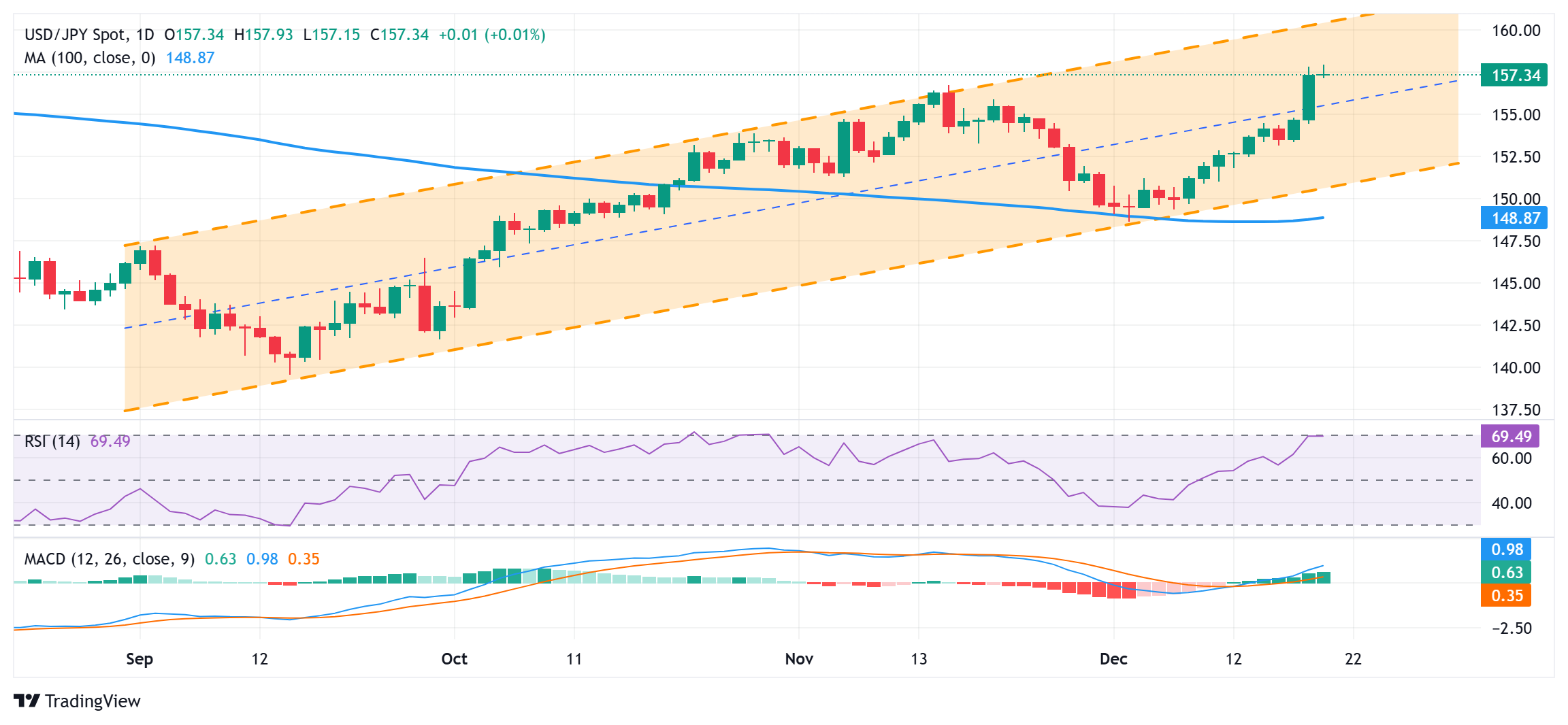Japanese Yen bulls remain on the sidelines despite strong Japan’s National CPI print
- The Japanese Yen adds to the post-BoJ losses and drops to a five-month low against the USD.
- The Fed’s hawkish shift remains supportive of elevated US bond yields and undermines the JPY.
- A stronger-than-expected Japan’s National CPI keeps the door open for a BoJ rate hike in 2025.
The Japanese Yen (JPY) prolongs a two-week-old downtrend and hits a five-month low against its American counterpart during the Asian session on Friday. The Bank of Japan (BoJ) kept rates steady in a nearly unanimous vote on Thursday and flagged a cautious outlook for 2025 amid sluggish economic growth, which, in turn, is seen weighing on the JPY. Moreover, the widening US-Japan bond yield differential contributes to driving flows away from the lower-yielding JPY.
Meanwhile, the Federal Reserve's (Fed) hawkish signal that it would slow the pace of rate cuts in 2025 helps the US Dollar (USD) to preserve its strong weekly gains to a two-year top. This further fuels the USD/JPY pair's strong move-up to the 158.00 neighborhood. However, data showing that the Japanese Consumer Price Index (CPI) grew slightly more than expected in November, which could push the BoJ to raise interest rates early in 2025, provides some respite to the JPY bulls.
Japanese Yen draws some support from higher-than-expected Japan’s National CPI print
- The Bank of Japan decided on Thursday to keep the short-term rate target unchanged in the range of 0.15%-0.25% and offered few clues on how soon it could push up borrowing costs.
- Data released by the Japan Statistics Bureau this Friday showed that the National Consumer Price Index (CPI) climbed 2.9% YoY in November, compared to the previous reading of 2.3%.
- Additional details of the report revealed that the National CPI ex Fresh food arrived at 2.7% YoY during the reported month versus 2.3% in October and was above expectations of 2.6%.
- Moreover, CPI ex Fresh Food, Energy rose 2.7% YoY in November, compared to the 2.3% rise recorded in the previous month, keeping hopes alive for a potential rate hike in January or March.
- In fact, BoJ Governor Kazuo Ueda reiterated the central bank's resolve to keep raising interest rates from their current very low levels if the economy and prices move in line with its forecasts.
- The Federal Reserve indicated on Wednesday that policymakers see the fed funds rate falling to 3.9% in 2025, suggesting two quarter-point rate cuts compared to four projected in September.
- The yield on the benchmark 10-year US government bond shot to its highest level in more than six months on Thursday, lifting the US Dollar to a two-year peak and undermining the Japanese Yen.
- The focus now shifts to the US Personal Consumption Expenditure (PCE) Price Index, or the Fed's preferred inflation gauge, which should provide a fresh impetus to the USD/JPY pair.
USD/JPY dips below the 157.00 mark might still be seen as a buying opportunity
From a technical perspective, the overnight strong move up beyond the previous multi-month top, around the 156.75 area, was seen as a fresh trigger for bullish traders. That said, the Relative Strength Index (RSI) has moved on the verge of breaking into the overbought territory on the daily chart. This makes it prudent to wait for some near-term consolidation or a modest pullback before positioning for any further gains.
Any meaningful slide below the 157.00 mark, however, now seems to find some support near the 156.75 region. Some follow-through selling could pave the way for a deeper corrective fall and drag the USD/JPY pair to the 156.00 round figure. The next relevant support is pegged near the 155.50 horizontal zone, below which spot prices could drop to the 155.00 psychological mark. The latter should act as a key pivotal point, which if broken decisively might shift the near-term bias in favor of bearish traders.
On the flip side, bullish traders might now wait for a move beyond the 158.00 mark before placing fresh bets. The USD/JPY pair might then accelerate the positive move toward the 158.45 intermediate hurdle before aiming to reclaim the 159.00 round figure. The momentum could extend further towards the 159.60-159.65 region en route to the 160.00 psychological mark and the 160.20 hurdle. The latter coincides with the top boundary of the multi-month-old ascending channel and should act as a strong barrier.
Economic Indicator
National Consumer Price Index (YoY)
Japan’s National Consumer Price Index (CPI), released by the Statistics Bureau of Japan on a monthly basis, measures the price fluctuation of goods and services purchased by households nationwide. The YoY reading compares prices in the reference month to the same month a year earlier. Generally, a high reading is seen as bullish for the Japanese Yen (JPY), while a low reading is seen as bearish.
Read more.Last release: Thu Dec 19, 2024 23:30
Frequency: Monthly
Actual: 2.9%
Consensus: -
Previous: 2.3%
Source: Statistics Bureau of Japan



